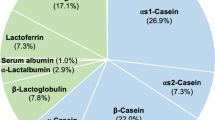Abstract
We aimed to investigate zinc and copper concentrations in breast milk at two months postpartum and the relationship between these concentrations and the characteristics of mother infant dyads. A total of 142 mothers were enrolled. The median concentrations of breast milk Zinc and Copper were 625 μg/L and 239 μg/L, respectively. These concentrations were not related to maternal age, parity, smoking habits, iron and vitamin/mineral supplementation, birthweight, gestational age, or feeding type. The concentrations had no effect on anthropometric measurements of infants at two months of age.
Similar content being viewed by others
References
World Health Organization (WHO). Report of a Joint WHO/IAEA Collaborative Study. Minor and Trace Elements in Breastmilk. World Health Organization, Geneva, 1989.
Prasad AS. Impact of the discovery of human zinc deficiency on health. J Am Coll Nutr. 2009;28:257–65.
Turski ML, Thiele DJ. New roles for copper metabolism in cell proliferation, signaling, and disease. J Biol Chem. 2009;284:717–21.
Feeley RM, Eitenmiller RR, Jones JB Jr, Barnhart H. Copper, iron, and zinc contents of human milk at early stages of lactation. Am J Clin Nutr. 1983;37:443–8.
Leotsinidis M, Alexopoulos A, Kostopoulou-Farri E. Toxic and essential trace elements in human milk from Greek lactating women: association with dietary habits and other factors. Chemosphere. 2005;61:238–47.
Ustundag B, Yilmaz E, Dogan Y, Akarsu S, Canatan H, Halifeoglu I, et al. Levels of cytokines (IL-1beta, IL-2, IL-6, IL-8, TNF-alpha) and trace elements (Zn, Cu) in breast milk from mothers of preterm and term infants. Mediators Inflam. 2005;6:331–6.
Yalçin SS, Baykan A, Yurdakök K, Yalçin S, GücüÞ AI. The factors that affect milk-to-serum ratio for iron during early lactation. J Pediatr Hematol Oncol. 2009;31:85–90.
Almeida AA, Lopes CM, Silva AM, Barrado E. Trace elements in human milk: correlation with blood levels, inter-element correlations and changes in concentration during the first month of lactation. J Trace Elem Med Biol. 2008;22:196–205.
Neville MC, Keller RP, Seacat J, Casey CE, Allen JC, Archer P. Studies on human lactation. I. Within-feed and between-breast variation in selected components of human milk. Am J Clin Nutr. 1984;40:635–46.
Silvestre MD, Lagarda MJ, Farré R, Martínez-Costa C, Brines J, Molina A, et al. A study of factors that may influence the determination of copper, iron, and zinc in human milk during sampling and in sample individuals. Biol Trace Elem Res. 2000;76:217–27.
Mahdavi R, Nikniaz L, Gayemmagami SJ. Association between zinc, copper, and iron concentrations in breast milk and growth of healthy infants in tabriz, Iran. Biol Trace Elem Res. 2010;135:174–81.
Author information
Authors and Affiliations
Corresponding author
Electronic supplementary material
Rights and permissions
About this article
Cite this article
Örün, E., Yalçin, S.S., Aykut, O. et al. Zinc and copper concentrations in Breastmilk at the second month of lactation. Indian Pediatr 49, 133–135 (2012). https://doi.org/10.1007/s13312-012-0021-9
Received:
Revised:
Accepted:
Published:
Issue Date:
DOI: https://doi.org/10.1007/s13312-012-0021-9




